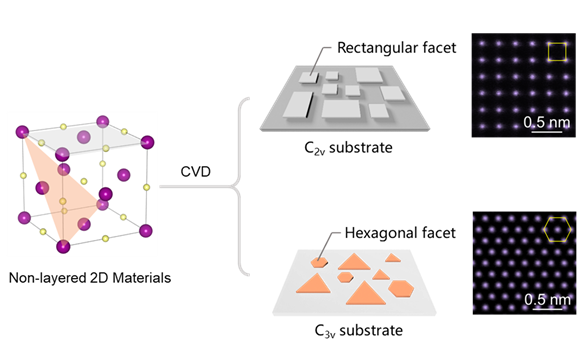Unveiling the Singular Symmetry in Facet-Engineered 2D Materials Growth
Published 29 December, 2023
In a crystal, facets refer to the planes composed of different atom arrangements. In nature, crystals tend to form a polyhedral shape as a result of multi-facets, and realizing a single-facet in a crystal is very challenging. Nonetheless, in a study published in the KeAi journal Advanced Powder Materials, a group of researchers from China outlined a new synthesis approach that can synthesize large-area 2D materials with atomic thickness and expose single facets at the same time.
"The exposed facet is crucial since it determines the surface structure and property of 2D materials," explains first author of the study Jingwei Wang, Shuimu Scholar at Shenzhen International Graduate School, Tsinghua University. "Previously, most researchers used wet-chemistry methods to synthesize nanoparticles with specific facets. However, these samples suffer from small surface area, low quality, and the presence of multiple facets which is not suitable for studying the identical properties of one certain facet.”
The study's multidisciplinary team of scientists found that using a three-fold symmetric growth substrate, such as mica, yields 2D MnSe crystals with a (111) facet. Conversely, on a two-fold symmetric substrate like MgO (100), 2D MnSe crystals with (100) facets can be grown. These 2D MnSe flakes not only exhibit large-area surfaces of single-facet but also possess high crystallinity and ordered domain orientation. They further prove that these samples are ideal candidates for studying facet-dependent properties (e.g. electrocatalysis).
"Until now, revealing the relationship between crystal facet and properties is challenging since the nanomaterials usually expose multi-facets. Our approach shows that the single-facet can be controlled in atomic thin 2D materials on specific growth substrates." says Bilu Liu, the corresponding author of the study."We hope that our results encourage scientists to continue investigating facet-engineering of 2D materials for desired properties and applications."

Contact author details: Bilu Liu, Shenzhen Geim Graphene Center, Tsinghua-Berkeley Shenzhen Institute and Institute of Materials Research, Shenzhen International Graduate School, Tsinghua University, Shenzhen, 518055, P. R. China bilu.liu@sz.tsinghua.edu.cn
Funder: This work was supported by the National Science Fund for Distinguished Young Scholars (52125309), the National Natural Science Foundation of China (51991343, 51920105002, and 52102179), Guangdong Basic and Applied Basic Research Foundation (2023A1515011752), Guangdong Innovative and Entrepreneurial Research Team Program (2017ZT07C341), Shenzhen Basic Research Project (JCYJ20200109144616617, JCYJ20220818101014029), Shuimu Tsinghua Scholar Program (2022SM092), and China Postdoctoral Science Foundation (2021M691715).
Conflict of interest: The authors declare that they have no known competing financial interests or personal relationships that could have appeared to influence the work reported in this paper.
See the article: Wang, J. et al., Facet-Engineered Growth of Non-Layered 2D Manganese Chalcogenides, Advanced Powder Materials, Volume 3, Issue 2, 2023, Pages 100164. https://doi.org/10.1016/j.apmate.2023.100164

